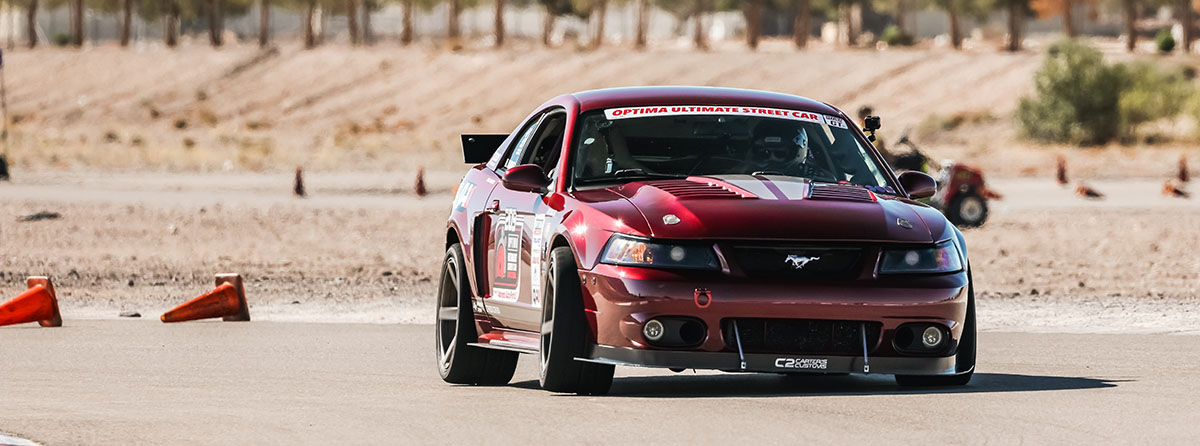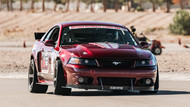TUNING YOUR PRO TOURING CAR
Whether you’re taking your pro touring car to the autocross for the first time or thrashing your dedicated track rig, you know there’s always room to get faster. And a little bit of suspension tuning can go a long way when you’re trying to find more speed. While there’s a lot that goes into the handling of your car—from geometry and spring rates and to weight splits and sway bars—shock tuning is a quick and easy way to make adjustments that improve performance.

HOW DO SHOCKS WORK?
Shocks go through two different movements: compression and rebound. Compression happens when the shock’s two mounting points move closer together. This occurs when the chassis moves toward the ground as the rear end squats or the front end dives.
Rebound happens the two shock mounting points move further apart. This occurs when the chassis moves away from the ground, as the front or rear suspension lifts.
HOW TO DESCRIBE THE HANDLING OF YOUR CAR
There are two main terms used to describe handling characteristics, typically referred to as understeer and oversteer.
Understeer, also known as a “push," happens when the front end does not want to grip and turn the vehicle the same direction as the front tires. A sign of understeer is excessive steering input in the direction you’re trying to turn. For instance, you try to make a hard left and the car only slightly turns left or continues straight. You may also hear the front tire chatter as it repeatedly loses and attempts to regain traction throughout the turn.
Oversteer or “loose” handling occurs when the rear end does not want to grip. A sign of oversteer is back and forth steering input or applying an excessive amount of opposite lock. If you have to turn right to go left, you’re experiencing oversteer. This is an attempt to keep the rear end from kicking out and over-rotating (spinning out).
HOW TO WORK THROUGH HANDLING PROBLEMS
Handling characteristics can change from segment to segment throughout a corner. Often, it will be the opposite of the previous segment. For instance, oversteer during corner entry will cause you to use less steering input and result in mid-corner understeer. This is why it is important to tune the handling at the first segment of the corner. Once that is in good shape, you can move on to tuning the next segment of the corner.
HOW TO TUNE YOUR SHOCKS
You may have single- or double-adjustable shocks. Single adjustable shocks have only one knob. This tunes both compression and rebound with one twist. They are very simple to use but come with a trade off by limiting your tuning abilities. You can only make wholesale changes, softening or stiffening the overall damping of your shocks.
With double-adjustable shocks, you have the ability to independently adjust your compression and rebound. This is more ideal and allows you do much more fine tuning. You’ll see why that comes in handy shortly.
When making shock adjustments, you will need to make bigger or smaller adjustments depending on the severity of your handling issues. For poor handling, make adjustments in 6-8 click increments from your current settings. For moderate to poor handling make adjustments in 3-6 increments from current settings. Good to moderate handling may only require 2-3 clicks of adjustment.
Now that you know how to tune your shocks, let's look at when and why.
TUNING CORNER ENTRY
As you come up to the corner, you’re likely slowing down. This causes the chassis to dive on the front end. Your car’s weight will transfer from the rear to the front. Transferring that weight too quickly can cause the car to oversteer. You’re suddenly taking all the weight off the rear of the chassis, causing the tires to quickly lose grip.
If the weight transfer happens too slowly, it will cause the vehicle to under steer. The weight is still over the rear tires, giving them more grip and overpowering the front end. This will cause the vehicle to push through the front tires because they don’t have the necessary grip to turn the vehicle.
Deceleration due to braking, dropping RPM, spring rates and chassis geometry are other factors that will affect how fast the vehicle transfers weight to the front on corner entry. But here are some basic shock adjustments you can make to counteract handling issues you’re experiencing.
Oversteer
- Increase Rebound in rear
- Increase Front Compression
Understeer
- Soften Compression in front
- Soften Rebound in rear
- Mid-corner tuning
TUNING MID-CORNER
By mid-corner, the chassis has typically taken a set. The shock is not moving very much, which means the valving has less of an effect on the overall handling. Factors like front and rear roll centers, sway bars, caster and camber all contribute to a vehicle’s handling through the center of the corner.
If one end of the vehicle has movement or roll in the center of the corner, that end will typically want to lose grip because it does not have enough rebound. This causes it to over-load the outside tire. If one end of the vehicle has tire chatter, it typically has too much damping and will need softer rebound for more grip.
Oversteer
- Increase rear rebound if rear suspension is unstable or has excessive body roll
- Decrease rear rebound if rear tires chatter and don’t have enough side bite
Understeer
- Increase front rebound if front suspension is unstable or has excessive body roll
TUNING CORNER EXIT
During corner exit, the front of the car will start to lift and transfer weight to the rear as you straighten out and increase throttle. Transferring that weight too quickly will cause the front tires to lose grip and understeer. If the weight transfers too slowly, it will cause the vehicle to spin the rear wheels and can lead to oversteer. Acceleration rate, spring rates and suspension geometry are other factors that affect how quickly the vehicle transfers weight to the rear.
Oversteer
- Reduce rear compression and increase rear rebound
- Soften front rebound
Understeer
- Increase front rebound
- Increase rear compression
OTHER CONSIDERATIONS
As mentioned before, shocks are only part of the overall equation and are often best used as tuning devices. They are rarely the best way to make wholesale changes to your car's handling on the track. You may need to change your geometry, weight balance, spring rates, etc to get your vehicle to perform its absolute best. If you're trying to remedy handling woes, make sure there aren't problems elsewhere in the car. There could be a bind somewhere in the suspension or mechanical gremlins in critical systems like the steering and brakes.
The difference between a "great handling car" and a "poor handling car" can also come down to the person behind the wheel. For one, some drivers like a "tighter" setup while others prefer a "looser" setup. This is all about driving style and personal preference. On top of that, we have to look at experience levels. Anyone and everyone should get out and track a car. But real speed comes with time and practice. Inexperienced drivers may use steering, braking or throttle inputs that upset the chassis, loading or unloading different corners of the car too quickly. This may cause you to think there is a handling issue when there isn't.
Last but not least, make sure you have a solid baseline and understanding of the issue before throwing changes at the car. If the problem isn't consistent, it could be an idicator that the driver isn't consistent. This can cause you to chase phantom issues or overcorrect when making changes.
Still have questions?
Finding speed through tuning can be a very gratifying experience. On the flipside, chasing your tail can be incredibly frustrating. Our team is here to help you get the most out of your shocks at the track. Feel free to contact us if you have questions or would like some help tuning your shocks.

